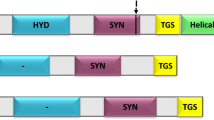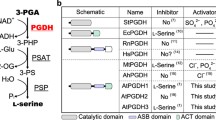Abstract
In this report we demonstrate that plastid glutamine synthetase of Medicago truncatula (MtGS2) is regulated by phosphorylation and 14-3-3 interaction. To investigate regulatory aspects of GS2 phosphorylation, we have produced non-phosphorylated GS2 proteins by expressing the plant cDNA in E. coli and performed in vitro phosphorylation assays. The recombinant isoenzyme was phosphorylated by calcium dependent kinase(s) present in leaves, roots and nodules. Using an (His)6-tagged 14-3-3 protein column affinity purification method, we demonstrate that phosphorylated GS2 interacts with 14-3-3 proteins and that this interaction leads to selective proteolysis of the plastid located isoform, resulting in inactivation of the isoenzyme. By site directed mutagenesis we were able to identify a GS2 phosphorylation site (Ser97) crucial for the interaction with 14-3-3s. Phosphorylation of this target residue can be functionally mimicked by replacing Ser97 by Asp, indicating that the introduction of a negative charge contributes to the interaction with 14-3-3 proteins and subsequent specific proteolysis. Furthermore, we document that plant extracts contain protease activity that cleaves the GS2 protein only when it is bound to 14-3-3 proteins following either phosphorylation or mimicking of phosphorylation by Ser97Asp.









Similar content being viewed by others
Abbreviations
- GS:
-
glutamine synthetase
- GS2:
-
plastid GS
- NR:
-
nitrate reductase
- Ni-NTA:
-
nickel-nitrilotriacetic acid
- 6x his-tag:
-
six histidine tag
References
Adam Z (1996) Protein stability and degradation in chloroplasts. Plant Mol Biol. 32: 773–83
Callis J (1995) Regulation of protein degradation. Plant Cell 7: 845–857
Carvalho H, Cullimore JV (2003) Regulation of glutamine synthetase isoenzymes and genes in the model legume Medicago truncatula. In: Pandalai SG (ed) Recent research developments in plant molecular biology, vol 1, part 1. Research Signpost Publishers.Trivandrum, pp. 157–175
Cock JM, Brock IW, Watson AT, Swarup R, Morby AP, Cullimore JV (1991) Regulation of glutamine synthetase genes in leaves of Phaseolus vulgaris. Plant Mol Biol 17:761–771
Cock JM, Hermon P, Cullimore JV (1992) Characterization of a gene encoding the plastid-located glutamine synthetase of Phaseolus vulgaris: regulation of β–glucuronidase gene fusions in transgenic tobacco. Plant Mol Biol 18: 1141–1149
Cotelle V, Meek SEM, Provan F, Milne FC, Morrice N, Mackintosh C (2000) 14–3-3s regulate cleavage of their diverse binding partners in sugar-starved Arabidopsis cells. EMBO J 19:2869–2876
Cullimore JV, Miflin BJ (1984) Immunological studies on glutamine synthetase using antisera raised to the two plant forms of the enzyme from Phaseolus root nodules. J Exp Bot 35:581–587
Cullimore JV, Sims AP (1980) An association between photorespiration and protein catabolism: studies in Chlamydomonas. Planta 150:392–396
Dubois F, Brugiere N, Sangwan RS, Hirel B (1996) Localization of tobacco citosolic glutamine synthetase enzymes and corresponding transcripts shows organ and cell-specific patterns of protein synthesis and gene expression. Plant Mol Biol 31:803–817
Finnemann J, Schjoerring JK (2000) Post-translational regulation of cytosolic glutamine synthetase by reversible phosphorylation and 14–3-3 protein interaction. Plant J 24:171–181
Forde BG, Cullimore JV (1989) The molecular biology of glutamine synthetase in higher plants. In: Miflin B (ed) Oxford Survey Plant Mol Cell Biol, vol 6. Oxford University Press, pp 247–296
Forde BG, Day HM, Turton JF, Shen W-J, Cullimore JV, Oliver JE (1989) Two glutamine synthetases genes from Phaseolus vulgaris L. display contrasting developmental and special patterns of expression in transgenic Lotus corniculatus plants. Plant Cell 1:391–401
Frohlich V, Fischer A, Ochs G, Wild A, Feller U (1994) Proteolytic inactivation of glutamine synthetase in extracts from wheat leaves: effects of pH, inorganic ions and metabolites. Aust J Plant Physiol 21:303–310
Hardin SC, Huber SC (2004) Proteasome activity and the post-translational control of sucrose synthase stability in maize leaves. Plant Physiol Biochem 42:197–208
Hardin SC, Tang G-Q, Scholz A, Holtgraewe D, Winter H, Huber SC (2003) Phosphorylation of sucrose synthase at serine 170: occurrence and possible role as a signal for proteolysis. Plant J 35:588–603
Hoelzle I, Finner JJ, McMullen MD, Streeter JG (1992) Induction of glutamine synthetase activity in nonnodulated roots of Glicine max, Phaseolus vulgaris and Pisum sativum. Plant Physiol 100:525–528
Huber SC, Bachmann M, Huber JL (1996) Post-translational regulation of nitrate reductase activity: a role for Ca2+ and 14–3-3 proteins. Trends Plant Sci 1:432–438
Journet EP, van Tuinen D, Gouzy J, Carreau V, Farmer MJ, Niebel A, Schiex T, Crespeau H, Jaillon O, Chatagnier O, Godiard L, Gianinazzi-Pearson V, Kahn D, Gamas P (2002) Exploring the root symbiotic programs of the model legume Medicago truncatula using EST analysis. Nucleic Acids Res 30: 5579–5592
Kaiser WM, Weiner H, Kandlbinder A, Tsai C-B, Rockel P, Sonoda M, Planchet E (2002) Modulation of nitrate reductase: some new insights, an unusual case and potentially important side reaction. J Exp Bot vol 53:875–882
Lea PJ, Robinson SA, Stewart GR (1990) The enzymology and metabolism of glutamine, glutamate and asparagine. In: Miflin BJ, Lea PJ (eds) The Biochemistry of Plants, vol 16. Academic Press, New York, pp 121–160
Li MG, Villemur R, Hussey PJ, Silflow CD, Gantt JS, Snustad DP (1993) Differential expression of six glutamine synthetase genes in Zea mays. Plant Mol Biol 23:401–407
Lullien V, Barker DG, da Lajudie P, Huguet T (1987) Plant gene expression in effective and ineffective root nodules of alfalfa (Medicago sativa). Plant Mol Biol 9:469–478
Mackintosh C, Meek SE (2001) Regulation of plant NR activity by reversible phosphorylation, 14–3-3 proteins and proteolysis. Cell Mol Life Sci 58:205–214
Man H-M, Kaiser WM (2001) Increased glutamine synthetase activity and changes in amino acid pools in leaves treated with 5-aminoimidazole-4-carboxiamide ribonucleoside (AICAR). Physiol Plant 111:291–296
Melo PM, Lima LM, Santos IM, Carvalho HG, Cullimore JV (2003) Expression of the plastid-located glutamine synthetase of Medicago truncatula. Accumulation of the precursor in root nodules reveals an in vivo control at the level of protein import into plastids. Plant Physiol 132:390–399
Moorhead G, Douglas P, Cotelle V, Harthill J, Morrice N, Meek S, Deiting U, Stitt M, Scarabel M, Aitken A, Mackintosh C (1999) Phosphorylation-dependent interactions between enzymes of plant metabolism and 14–3-3 proteins. Plant J 18:1–12
Muslin AJ, Tanner JW, Allen PM, Shaw AS (1996) Interaction of 14–3-3 with signalling proteins is mediated by the recognition of phosphoserine. Cell 84:889–897
Oliveira IC, Lam H-M, Coschigano K, Melo-Oliveira R, Coruzzi G (1997) Molecular-genetic dissection of ammonium assimilation in Arabidopsis thaliana. Plant Physiol Biochem 35:185–198
Ortega JL, Roche D, Sengupta-Gopalan C (1999) Oxidative turnover of soybean root glutamine synthetase. In vitro and in vivo studies. Plant Physiol 119:1483–1495
Ortega JL, Temple SJ, Sengupta-Gopolan C (2001) Constitutive overexpression of cytosolic glutamine synthetase (GS1) gene in transgenic alfalfa demonstrates that GS1 may be regulated at the level of RNA stability and protein turnover. Plant Physiol 126:109–121
Ortega JL, Temple SJ Bagga S, Ghoshroy S, Sengupta-Gopolan C (2004) Biochemical and molecular characterization of transgenic Lotus japonicus plants constitutively overexpressing a cytosolic glutamine synthetase gene. Planta 219:807–818
Palatnik JF, Carrillo N, Valle EM (1999) The role of photosynthetic electron transport in the oxidative degradation of chloroplastic glutamine synthetase. Plant Physiol. 121: 471–478
Pozuelo M, Mackintosh C, Galvan A, Fernandez E (2001) Cytosolic glutamine synthetase and not nitrate reductase from the green alga Chlamydomonas reinhardtii is phosphorylated and binds 14–3-3 proteins. Planta 212:264–269
Riedel J, Tischner R, Mäck G (2001) The chloroplastic glutamine synthetase (GS-2) of tobacco is phosphorylated and associated with 14–3-3 proteins inside the chloroplast. Planta 213:396–401
Roche D, Temple SJ, Sengupta-Gopalan C (1993) Two classes of differentially regulated glutamine synthetase genes are expressed in the soybean nodule: a nodule-specific class and a constitutively expressed class. Plant Mol Biol 22:971–983
Roulin S, Feller U (1997) Light-induced proteolysis of stromal proteins in pea (Pisum sativum L.) chloroplasts: requirement for intact organelles. Plant Sci 128:31–41
Sakakibara H, Kawabata S, Takahashi H, Hase T, Sugiyama T (1992) Molecular cloning of the family of glutamine synthetase genes from maize: expression of genes for glutamine synthetase and ferredoxin-dependent glutamate synthase in photosynthetic and non-photosynthetic tissues. Plant Cell Physiol 33:49–58
Streit L, Feller U (1983) Chandging activities and different resistence to proteolytic activity of two forms of glutamine synthetase in wheat leaves during senescence. Physiol Vég 21:103–108
Sukanya R, Li M-G, Snustad DP (1994) Root- and shoot-specific responses of individual glutamine synthetase genes of maize to nitrate and ammonium. Plant Mol Biol 26:1935–1946
Tang G-Q, Hardin SC, Dewey R, Huber SC (2003) A novel C-terminal proteolytic processing of cytosolic pyruvate kinase, its phosphorylation and degradation by the proteasome in developing soybean seeds. Plant J 34:77–93
Temple SJ, Heard J, Ganter G, Dunn K, Sengupta-Gopalan C (1995) Characterization of a nodule-enhanced glutamine synthetase from alfalfa: nucleotide sequence, in situ localization and transcript analysis. Mol Plant-Microbe Interact 8:218–227
Temple SJ, Heard J, Kunjibettu S, Roche D, Sengupta-Gopalan C (1996) Total glutamine synthetase activity during soybean nodule development is controlled at the level of transcription and holoprotein turnover. Plant Physiol 112:1723–1733
Temple SJ, Bagga S, Sengupta-Gopolan C (1998) Down-regulation of specific members of the glutamine synthetase gene family by antisense RNA technology. Plant Mol Biol 37:535–547
Thoenen M, Feller U (1998) Degradation of glutamine synthetase in intact chloroplasts isolated from pea (Pisum sativum) leaves. Aust J Plant Physiol 25:279–286
Toroser D, Athwal GS, Huber SC (1998) Site-specific regulatory interaction between spinach leaf sucrose-phosphate synthase and 14–3-3 proteins. FEBS Lett 435:110–114
Walker EL, Coruzzi GM (1989) Developmental regulated expression of the gene family for cytosolic glutamine synthetase in Pisum sativum. Plant Physiol 91:702–708
Weiner H, Kaiser WM (1999) 14–3-3 proteins control proteolysis of nitrate reductase in spinach leaves. FEBS Lett 455:75–78
Yamamoto Y, Inagaki N, Satoh K (2001) Overexpression and characterization of carboxyl-terminal processing protease for precursor D1 protein: regulation of enzyme-substrate interaction by molecular environments. J Biol Chem 276(10): 7518–25
Acknowledgments
We gratefully acknowledge Dr. Carol Mackintosh (MRC unit, University of Dundee, UK) for providing anti-14-3-3 antibodies. We are also extremely grateful to Michel Rossignol and Giselle Borderie (IFR40, Toulouse, France) for expert assistance in 2D electrophoresis. We are also grateful to Jorge Azevedo and Pedro Pereira (IBMC, Porto, Portugal) for helpful discussions. This work was supported by the Fundação para a Ciência e Tecnologia (Project no. POC/PI/41433/2001)
Author information
Authors and Affiliations
Corresponding author
Rights and permissions
About this article
Cite this article
Lima, L., Seabra, A., Melo, P. et al. Phosphorylation and subsequent interaction with 14-3-3 proteins regulate plastid glutamine synthetase in Medicago truncatula . Planta 223, 558–567 (2006). https://doi.org/10.1007/s00425-005-0097-8
Received:
Accepted:
Published:
Issue Date:
DOI: https://doi.org/10.1007/s00425-005-0097-8




